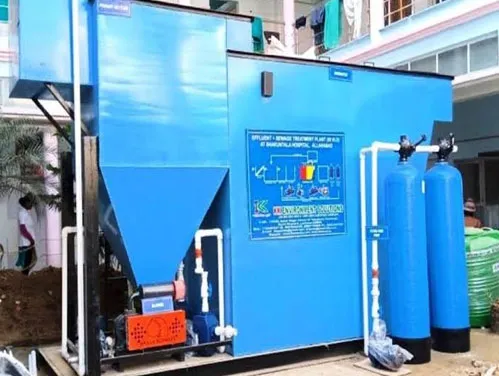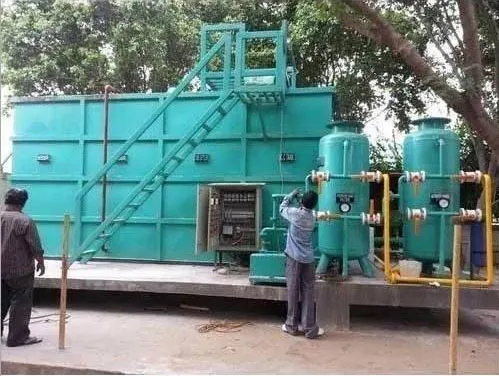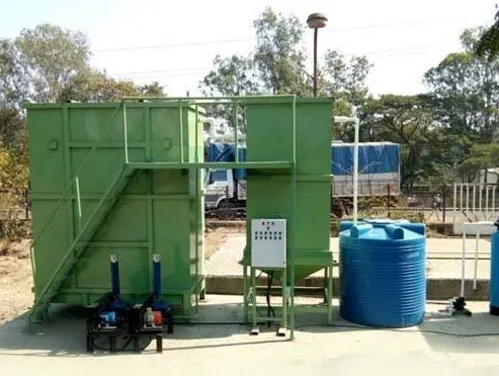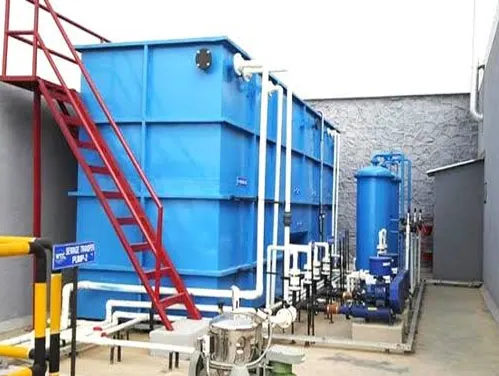Sewage/Wastewater Treatment Plant Manufacturer & Supplier in India
In the bustling metropolis of Delhi, the importance of effective wastewater management is underscored by the presence of state-of-the-art Sewage Treatment Plants. These crucial facilities play a pivotal role in maintaining the city's environmental equilibrium by treating and purifying sewage.
Among the key contributors to this vital infrastructure are local Sewage Treatment Plant manufacturers, specializing in cutting-edge technology to ensure optimal performance. The collaboration between these manufacturers and municipal authorities has led to the establishment of innovative Sewage Treatment Plants in Delhi.
These plants not only adhere to stringent environmental standards but also reflect the city's commitment to sustainable development. As a result, the Wastewater Treatment Plants in Delhi NCR have become benchmarks for urban centers grappling with the challenges of rapid urbanization and increasing wastewater generation.
The synergy between government initiatives and the expertise of Sewage Treatment Plant manufacturers in Delhi NCR exemplifies a concerted effort towards creating a cleaner and healthier living environment for the city's residents.
Looking for a trusted sewage or wastewater treatment plant manufacturer in Delhi NCR? Discover our range of high-quality systems designed for efficient wastewater treatment. As a reputable manufacturer, we provide reliable solutions for residential, commercial, and industrial applications.
A sewage treatment plant is a facility where sewage is treated before it is discharged into the environment. Sewage treatment involves the removal of contaminants from wastewater and household sewage. It is important to treat sewage because it can contain harmful bacteria, viruses, and other pollutants that can cause disease.
Sewage also contains nutrients that can lead to the growth of algae and other aquatic plants. If sewage is not treated, it can pollute rivers, lakes, and coastal areas. There are several different types of sewage treatment plants, but all of them use some combination of physical, chemical, and biological processes to remove pollutants.
A sewage or wastewater treatment plant is a facility where wastewater is treated before it is discharged into the environment. Wastewater includes sewage from toilets, showers, and sinks as well as stormwater runoff.
Sewage treatment plants come in many different sizes and configurations, but all have the same basic purpose: to remove contaminants from wastewater so that it can be safely released into the environment.
There are three main steps in sewage treatment: primary, secondary, and tertiary.
1. Primary treatment involves removing large solids from the wastewater. This is typically done by screening or sedimentation.
2. Secondary treatment removes smaller particles and dissolved substances from the wastewater. This is usually done with biological processes like aeration and activated sludge.
3. Tertiary treatment further cleans the water by removing remaining pollutants. This can be done with techniques like filtration, disinfection, and ultraviolet light.
Sewage Treatment Plant Process Steps
The process steps of a sewage plant typically involve several stages to effectively treat wastewater.
- 1. Preliminary Treatment:
- 2. Primary Treatment:
- 3. Secondary Treatment:
- 4. Tertiary Treatment:
- 5. Disinfection:
- 6. Sludge Treatment:
- 7. Effluent Discharge:
- 8. Monitoring and Quality Control:
- 9. Oil and Grease Removal:
Removal of Large Debris: Incoming wastewater passes through screens or grates to remove large objects like sticks, rags, and plastics.
Grit Removal: Sand, gravel, and other heavy particles settle out in a settling chamber.A settling tank holds wastewater for heavier solids (sludge) to settle at the bottom, forming a layer. Operators skim off lighter materials like oil and grease from the surface.
Biological Treatment: The remaining wastewater undergoes biological treatment to remove organic pollutants. This often employs methods like activated sludge, trickling filters, or other biological reactors.
Trickling Filter: During this process, we trickle wastewater over a bed of rocks or plastic media. Microbe on the media break down organic matter.
Additional Filtration: This step involves further filtration to remove fine particles and impurities. It may include sand filtration or microfiltration.
Chlorination or UV Treatment: To kill or inactivate harmful viruses remaining in the treated water.
Anaerobic Digestion or Sludge Digestion: The sludge from the primary clarifier tank undergoes additional treatment. This process breaks down organic matter and yields biogas.
Dewatering: We then dewater the digested sludge to reduce its volume.
Release or Reuse: They discharge the treated water (effluent) into a receiving body of water (river or ocean) or may reuse it for irrigation.
They conduct regular testing and analysis to ensure that the effluent meets regulatory standards for water quality.
In this step, we employ physical processes like skimming or chemical methods. They aim to further remove any residual oil and grease from the water.
Keep in mind that these processes can differ depending on the design of the sewage treatment plant and the technology chosen by the manufacturer. Local regulations and environmental factors also play a role in shaping the treatment process.
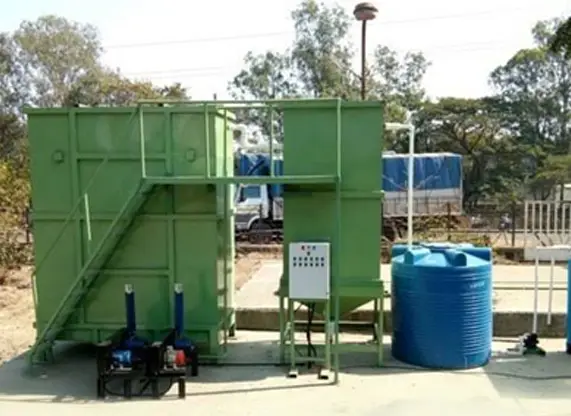
The Benefits of a Sewage Treatment Plant
A sewage treatment plant is a facility where wastewater from homes and businesses is treated before it is discharged into the environment. Wastewater contains pollutants that can be harmful to human health and the environment.
Sewage treatment plants remove these pollutants from wastewater so that it can be safely discharged into the environment. Treatment of sewage at a treatment plant also reduces the volume of sewage that must be disposed of in landfills.
There are many benefits to using a sewage treatment plant, including:
- Reduced pollution of waterways and ground water
- Protection of public health
- Reduced stink and odours from untreated sewage
- Less need for landfill space
Sewage Treatment Plant Maintenance
A sewage treatment plant is a facility where wastewater from homes and businesses is treated before it is discharged into the environment. Wastewater contains pollutants that can harm the environment and human health if not properly removed.
Sewage treatment plants remove pollutants from wastewater using physical, chemical, and biological processes. Physical processes remove solids from the water using screens or filters. Chemical processes remove dissolved pollutants using chemicals such as chlorine or alum. Biological processes use bacteria and other microorganisms to break down organic pollutants.
After the wastewater has been treated, it is discharged into a receiving water body such as a river, lake, or ocean. The receiving water body may also be used for irrigation, drinking water supply, or recreational activities such as swimming and fishing.
To protect public health and the environment, it is important to properly maintain sewage treatment plants. regular maintenance can help ensure that sewage treatment plants are operating efficiently and effectively
The Evolution of Sewage Treatment Plants in Delhi
The inception of sewage treatment plants in Delhi dates back to the establishment of New Delhi in 1938. At that time, they established an 82 million liters per day (mld) capacity Sewage Treatment Plant (STP) in Okhla. Over the years, there was a substantial augmentation in capacity, reaching 164 mld by 1956.
Subsequently, they constructed additional STPs at Coronation Pillar (55 mld) in 1957 and at Keshopur (55 mld) in 1960. The sewage water treatment capacity skyrocketed from 273 mld in 1961 to an impressive 1273 mld in 1993. Currently, the total capacity of sewage treatment plants in Delhi stands at a staggering 2330 Million Liters Per Day.
Extensive Sewerage Network
Delhi currently features a well-organized gravity collection sewerage system. This system includes an extensive network of branch, intercepting, peripheral, and trunk sewers, covering around 6000 kilometers. According to the Delhi Jal Board, there exist twenty-eight primary trunk sewers. They range in size from 700 millimeters to over 2400 millimeters in diameter, collectively spanning around 140 kilometers in length.
Pumping Stations: The Backbone of Sewerage Management
Delhi relies on 36 major pumping stations, with capacities ranging from 6 mld to an impressive 455 mld. Historically, the focus was primarily on providing clean drinking water to both urban and rural areas.
Unfortunately, the growth in sewerage facilities did not parallel the rate of sewage generation. Even today, the sewerage system covers only around 60% of Delhi's population. To address this, they have divided Delhi into six zones:
1. Rithala
2. Coronation Pillar
3. Keshopur
4. Okhla
5. Trans Yamuna
6. Outer Delhi
Expanding Horizons: Sewage Infrastructure in Urban Extensions
Apart from the established zones, newer urban extensions in Delhi/NCR like Narela, Pappan Kalan, Najafgarh, Ghitroni, Vasant Kunj, Mehrauli, and Sarita Vihar have seen the establishment of sewage treatment plants. As of December 2003, Delhi houses STPs at 17 different locations, collectively boasting a treatment capacity of 2330 mld (512.5 mgd). Plans are underway to further increase this capacity to 3389 mld by augmenting existing treatment plants and establishing new ones.
Segmentation of Sewerage Treatment
The Delhi Jal Board classifies the status of the sewerage treatment system based on various categories of inhabitants:
i) Planned Colonies: Approximately 40% of the population residing in planned colonies benefit from a fully developed sewerage system.
ii) Unauthorized-Regularized Colonies:
iii) Resettlement Colonies:
iv) Urban Villages:
This segmentation plays a crucial role in strategizing and organizing further developments in the sewerage infrastructure.
Cataloging Sewerage and Sewage Treatment Plants in Delhi
Here is a comprehensive list of sewage treatment plants in Delhi, along with their respective capacities and locations:
- 1. Nilothi (Capacity: 182 MLD)
- 2. Coronation Pillar (Capacity: 45 MLD)
- 3. Keshopur (Capacity: 55 MLD)
- 4. Okhla (Capacity: 55 MLD, 73 MLD, 136 MLD, 168 MLD, 205 MLD)
- 5. Yamuna Vihar Ph.-I (Capacity: 45 MLD)
- 6. Yamuna Vihar Ph.-II (Capacity: 45 MLD)
- 7. Timarpur O.P. (Capacity: 27 MLD)
- 8. Najafgarh (Capacity: 23 MLD)
- 9. N.H. (Capacity: 10 MLD)
- 10. Delhi Gate (Capacity: 10 MLD)
- 11. Papankalan (Capacity: 91 MLD)
- 12. Kondli Ph.-I (Capacity: 45 MLD)
- 13. Kondli Ph. II (Capacity: 114 MLD)
- 14. Kondli Ph.-III (Capacity: 45 MLD)
- 15. Mehrauli (Capacity: 23 MLD)
- 16. Rithala-Old (Capacity: 182 MLD)
- 17. STP –Rithala-New (Capacity: 182 MLD)
- 18. Ghitorni (Capacity: 23 MLD)
- 19. Narela (Capacity: 45 MLD)
- 20. Vasant Kunj (Capacity: 10 MLD, 14 MLD)
- 21. Rohini (Capacity: 68 MLD)
Conclusion
In closing, when it comes to sewage treatment plants in Delhi, Aqua Pristine is your top choice. We're a trusted manufacturer, dedicated to providing efficient and reliable solutions. Our sewage treatment plant manufacturer in Delhi offers cutting-edge technology designed to meet your needs. With a focus on quality, affordability, and eco-friendliness, Aqua Pristine ensures that every plant we make meets the highest standards. Whether you're a homeowner, business owner, or part of a municipality, our friendly team is here to help you find the perfect sewage treatment solution. Count on Aqua Pristine for all your sewage treatment needs in Delhi and beyond.
Sewage Treatment Plant Can be Used in the Following Places
- Homes
- Apartment Buildings
- Hotels
- Hospitals
- Shopping Malls
- Schools
- Business Parks
- Industrial Parks
- Prisons
- Military Installations
(Note: This article is based on a paper by Yamuna Riverfront in 2003. For the most up-to-date information, refer to the Delhi Pollution Control Board website.)
Location We Serve
Copyright 2022 Aqua Pristine. All Rights Reserved

